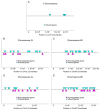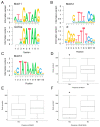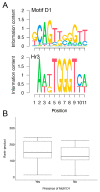Meta-Analysis of Immune Induced Gene Expression Changes in Diverse Drosophila melanogaster Innate Immune Responses
- PMID: 35621824
- PMCID: PMC9147463
- DOI: 10.3390/insects13050490
Meta-Analysis of Immune Induced Gene Expression Changes in Diverse Drosophila melanogaster Innate Immune Responses
Abstract
Organisms are commonly infected by a diverse array of pathogens and mount functionally distinct responses to each of these varied immune challenges. Host immune responses are characterized by the induction of gene expression, however, the extent to which expression changes are shared among responses to distinct pathogens is largely unknown. To examine this, we performed meta-analysis of gene expression data collected from Drosophila melanogaster following infection with a wide array of pathogens. We identified 62 genes that are significantly induced by infection. While many of these infection-induced genes encode known immune response factors, we also identified 21 genes that have not been previously associated with host immunity. Examination of the upstream flanking sequences of the infection-induced genes lead to the identification of two conserved enhancer sites. These sites correspond to conserved binding sites for GATA and nuclear factor κB (NFκB) family transcription factors and are associated with higher levels of transcript induction. We further identified 31 genes with predicted functions in metabolism and organismal development that are significantly downregulated following infection by diverse pathogens. Our study identifies conserved gene expression changes in Drosophila melanogaster following infection with varied pathogens, and transcription factor families that may regulate this immune induction.
Keywords: Drosophila melanogaster; gene expression; innate immunity; pathogen infection; transcriptome analysis.
Conflict of interest statement
The authors declare no conflict of interest. The funders had no role in the design of the study; in the collection, analyses, or interpretation of data; in the writing of the manuscript, or in the decision to publish the results.
Figures





Similar articles
-
Induction and Suppression of NF-κB Signalling by a DNA Virus of Drosophila.J Virol. 2019 Jan 17;93(3):e01443-18. doi: 10.1128/JVI.01443-18. Print 2019 Feb 1. J Virol. 2019. PMID: 30404807 Free PMC article.
-
Autophagy and innate immunity: Insights from invertebrate model organisms.Autophagy. 2018;14(2):233-242. doi: 10.1080/15548627.2017.1389824. Epub 2018 Feb 17. Autophagy. 2018. PMID: 29130360 Free PMC article. Review.
-
The Oct1 homolog Nubbin is a repressor of NF-κB-dependent immune gene expression that increases the tolerance to gut microbiota.BMC Biol. 2013 Sep 6;11:99. doi: 10.1186/1741-7007-11-99. BMC Biol. 2013. PMID: 24010524 Free PMC article.
-
Drosophila Thor participates in host immune defense and connects a translational regulator with innate immunity.Proc Natl Acad Sci U S A. 2000 May 23;97(11):6019-24. doi: 10.1073/pnas.100391597. Proc Natl Acad Sci U S A. 2000. PMID: 10811906 Free PMC article.
-
Antiviral Immune Response and the Route of Infection in Drosophila melanogaster.Adv Virus Res. 2018;100:247-278. doi: 10.1016/bs.aivir.2017.10.006. Epub 2017 Nov 21. Adv Virus Res. 2018. PMID: 29551139 Review.
Cited by
-
Cell-death induced immune response and coagulopathy promote cachexia in Drosophila.bioRxiv [Preprint]. 2025 Feb 10:2025.01.07.631515. doi: 10.1101/2025.01.07.631515. bioRxiv. 2025. PMID: 39829769 Free PMC article. Preprint.
-
Hemocytes and fat body cells, the only professional immune cell types in Drosophila, show strikingly different responses to systemic infections.Front Immunol. 2022 Nov 23;13:1040510. doi: 10.3389/fimmu.2022.1040510. eCollection 2022. Front Immunol. 2022. PMID: 36505446 Free PMC article.
-
Glucocerebrosidase deficiency leads to neuropathology via cellular immune activation.bioRxiv [Preprint]. 2023 Dec 13:2023.12.13.571406. doi: 10.1101/2023.12.13.571406. bioRxiv. 2023. Update in: PLoS Genet. 2024 Nov 11;20(11):e1011105. doi: 10.1371/journal.pgen.1011105. PMID: 38168223 Free PMC article. Updated. Preprint.
-
Glucocerebrosidase deficiency leads to neuropathology via cellular immune activation.PLoS Genet. 2024 Nov 11;20(11):e1011105. doi: 10.1371/journal.pgen.1011105. eCollection 2024 Nov. PLoS Genet. 2024. PMID: 39527642 Free PMC article.
References
Grants and funding
LinkOut - more resources
Full Text Sources
Molecular Biology Databases

